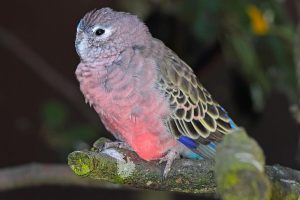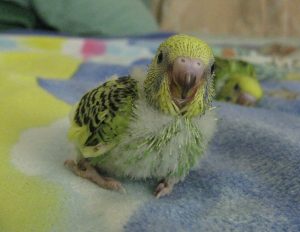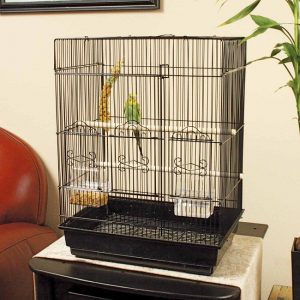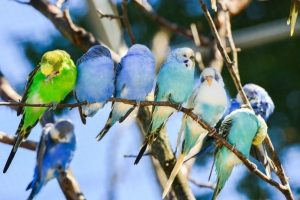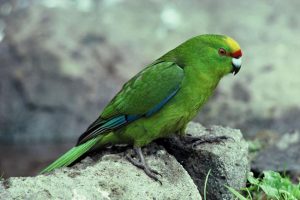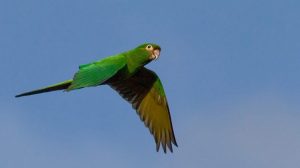Parakeets
Parakeets are small to medium-sized parrots characterized by their social disposition, gentle personality, and long feathers in their tail. Their name comes from the French word ‘perroquet’, which means parrot.
There are more than 120 species and subspecies of birds that can be termed parakeets, with the budgerigar, also known as the English parakeet, being the most common. The Alexandrine parakeet is the largest parrot to be referred to as a parakeet, and because of its size, it is sometimes referred to as the Alexandrine parrot.
List of Different Types of Parakeets
In aviculture, rosellas and conures are all considered parakeets, although some species may have shorter tail feathers than needed to qualify as a parakeet.
- Budgerigar (Budgie)
- Scarlet-chested Parakeet
- Dusky-headed Parakeet
- Monk Parakeet
- Ringneck Parakeet
- Alexandra’s Parakeet (Princess Parrot)
- Cuban Parakeet
- Plain Parakeet
- Yellow-chevroned Parakeet
- Mitred Parakeet
- Orange-chinned Parakeet
- Bourke’s Parakeet
- Olive Throated Parakeet
- Tui Parakeet
- Mustached Parakeet
- Brown-throated Parakeet
- Red Rump Parakeet
- Lineolated Parakeet (Barred Parakeet)
- Plum-headed Parakeet
- Blue-winged Parakeet
- White-winged Parakeet
Habitat
Parakeets can be found in many different habitats, with the budgie primarily inhabiting the dry areas in Australia and many other parakeets living in the rainforests of South America.
Mating & Breeding
In their habitats in the wild, parakeets live in vast flocks but choose a single partner for life, forming monogamous pairs. For most species, the mating season falls in spring. Their age of sexual maturity varies between species, with the budgie, for example, becoming mature at 3 to 5 months of age.
In the wild, they do not start to breed from such a young age and wait to be at least 10 months to a year before beginning to mate. Birds in captivity must also be given this time before they are made to breed.
The female parakeet usually lays between 6 and 8 eggs, incubating for around 18 days before hatching.
Lifespan
Parakeets are usually not as long-lived as macaws and cockatoos. Their average lifespan varies between 5 and 15 years. The longevity in captivity depends upon several factors, including a proper and balanced diet, mental enrichment, adequate interaction, etc.
Are Parakeets Good Pets
As pets, parakeets are among the most popular in the world, with the most common member, the budgie, being third in the list of animals kept as pets, after the dog and cat. Their affable personality, doubled by their ease of maintenance, makes them very popular as pets worldwide. Let us take a look at the nuances of keeping these sweet birds as a pet.
Housing and Cage
Parakeets are active birds and love to fly around in their nest. Keeping this in mind, they should be given as large an enclosure to live in as possible; even housing multiple parakeets in one cage wouldn’t be such a bad idea as long as there is enough room for all of them. The ideal cage size for a single parakeet is around 20x18x18 inches, while for a couple of these birds, the cage size must be augmented to 30x18x18 inches. There should also be enough room for toys, water, food, and perches.
Personality & Behavior
As mentioned earlier, parakeets are social, outgoing, and active birds. Since they live in a flock in the wild, in captivity, too, they usually do not take much time to get used to their human parents. They also adapt quickly to being captive and adjust quickly to their surroundings. These intelligent birds are one of the easiest in the parrot family to tame.
Do Parakeets Bite
Like all members of the animal kingdom, they indeed have a ‘fight or flight’ instinct, and if they feel cornered, they may lash out by biting. But this kind of behavior is rare and can be ironed out with training.
Are Parakeets Loud & Noisy
Often quite loud, they like to sing, chirp and squawk their time away. Their sounds may reach a fever pitch during the dawn and dusk, as it is their natural instinct in the wild to give out contact calls to their flock to disperse and congregate.
How to Care for a Parakeet
- Replace the dirty food and water trays every day with clean ones.
- Disinfect the cage once every 6 months; if you want, you can put this off until about a year, but not longer.
- Make sure your parakeet gets enough sleep, as they need it almost as much as you to maintain good health. Dimming the lights will get them to settle down before dozing off. The first light of morning will wake them up. Some species may need up to 10 hours of sleep per day.
- Provide a birdbath with clean water daily, as parakeets are rather hygiene-conscious. You may also choose to get in on the action yourself with the help of a mist spray. The third option would be to take them with you to the shower so you and your birds can bathe together. However, it will only work with proper training.
- Trim the nails and clip the wings on a regular basis. Place a few chew toys inside their cage to make sure to avoid an overgrown beak. Alternatively, you can also put a perch made of balsa wood inside the cage.
- Help them during molting (a ragged appearance is a sign that your bird has started to molt) as the old feathers fall off and new ones grow in their place. The latter starts as pinfeathers in hard shells, and you can help by removing the hard shafts from areas it might face difficulty reaching.
Diet
You can give your feathered friend a diet consisting of parakeet pellets, seeds, vegetables, and fruits on a daily basis. Cuttlebones are an excellent source of calcium for them, as are eggs, a good source of protein. Parakeets, in general, can also be occasionally given any healthy food that you might be having, including chicken, pasta, or wheat toast.
What Fruits Can Parakeets Eat
Parakeets are fond of fruits, specifically grapes, apples, pears, strawberries, melons, and kiwis are some of the fruits they enjoy, so offer them these as often as possible.
Never give parakeets chocolate or avocado, as both of these are toxic to them, leading to serious health complications.
Health Problems
Parakeets are usually quite hardy. Though some may get sick occasionally, with common health issues including mites, diarrhea, breathing trouble, poor appetite, feather-plucking, scratching, abnormal droppings, etc.
Most of these issues can be avoided through a balanced diet, constant interaction, and regular visits to a veterinarian.
Training
Because of their intelligence, training a parakeet is not much of a difficult task. Here are a few tips to keep in mind when you are training your bird:
- Use positive reinforcement whenever possible; a bird treat for a well-done job is a great idea. Inversely, negative reinforcement like shouting or beating the parakeet when it fails to pick up on something you just taught is a strict no-no.
- Become your bird’s favorite companion if you want it to learn, and remember the tricks you teach. Interact with it as much as you can to earn your bird’s trust.
Video: Parakeet training
Sounds and Call
Can Parakeets Talk
The ability of parakeets to talk may vary between species and even between individuals of the same species. Male budgies usually learn to mimic very well, but that is usually not the case with female budgerigars.
How to Teach a Parakeet to Talk
Parakeets can pick up natural sounds they hear around them, so make sure to let them spend a lot of time around you and your family as you talk about your day. You can also directly talk to the bird. At least leave a radio on near them at a moderate volume so that they can keep on hearing sounds that they can eventually learn to mimic.
Video: Parakeet talking & Singing
Price
Owing to their size and easy availability, parakeets are one of the most inexpensive birds to get as a pet. While the price varies from species to species, you can buy one of these darlings for anywhere between $10 and $60, with budgies costing the least.
Interesting Facts
- The Alexandrine parakeet is named after the Macedonian conqueror Alexander the Great, as he was the one who brought these birds to Europe from India after his conquests around 327 BC.
- The oldest recorded parakeet was 25 years old when it passed on.
- Although cockatiels are about the same size as many parakeets, they are not considered as such and are instead considered part of the cockatoo family.



